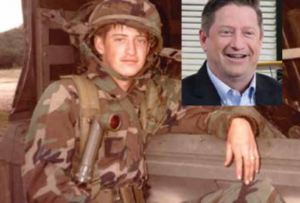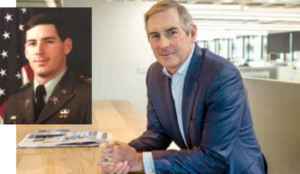 Adam Coffey, CEO, CoolSys: A mechanic by background, Coffey joined the Army as a radar repairman in 1982 and jumped out of helicopters with his toolbox until 1986. He became a sergeant and tech-section chief. Then Coffey served for two years in the U.S. Army reserves. Brea, California-based CoolSys is parent of retail and commercial refrigeration and HVAC companies.
Adam Coffey, CEO, CoolSys: A mechanic by background, Coffey joined the Army as a radar repairman in 1982 and jumped out of helicopters with his toolbox until 1986. He became a sergeant and tech-section chief. Then Coffey served for two years in the U.S. Army reserves. Brea, California-based CoolSys is parent of retail and commercial refrigeration and HVAC companies.
I’m a guest lecturer at UCLA, and I tell MBA students that if it weren’t for the military, I wouldn’t be here today. Military leadership taught me discipline, how to show up on time, how to get engaged and how to work as part of a larger group.
An army can’t function when everyone does as they please, so you learn early about unit cohesiveness. You learn to work with people with a diverse set of backgrounds. The Army is a true melting pot. You learn to work as a team and how to put the needs of the collective ahead of the needs of the individual. You learn about sacrifice and serving others.
I’ve spent 20 years as a CEO of three different national service companies in three industries, and I learned that every individual has value—but it’s the same value. I don’t value myself higher than a janitor in a plant. Titles are how you organize your efforts, but at the human level, everyone adds value. And diversity is important.
So you put these things together, and you manage believing that collective goals and objectives are ahead of any individual’s. You inspire a vision and build common goals and get people to aspire to do more than they can on their own. All of those lessons I learned in the military.
In fact, I call myself a consensus leader. That may sound counterintuitive to military training. But sometimes you respect a person because of their rank—and other times not just because of their rank but because they’ve inspired you and earned that leadership and respect.
I also apply military lessons in smaller—but still significant—ways. There’s a lot of regimentation and discipline around what we do. So, for example, our employees have stripes on their shirts that indicate their level of expertise. And if they are a military veteran, they can put a veteran tab on their uniform and a veteran sticker on their vehicle. Also, like the military does, we hand out “challenge coins” that represent the core values of our company.
And it’s funny—when you’re in the service, you spend every day thinking about how long it is until you get out. Once you do, you spend the rest of your life looking back with some sense of pride, and the little hassles you endured go away. But you remember the friendships and the good part about service, and you spend the rest of your life being a proud veteran.
 Sean Feeney, CEO, DefenseStorm: A West Point graduate, Feeney reached the rank of captain while serving in Germany in the Field Artillery from 1981 to 1985 and was an instructor at the U.S. Army Ordnance School for a year. Then he served in the Pennsylvania National Guard, rising to major. Alpharetta, Georgia-based DefenseStorm provides cybersecurity and compliance tech to the banking industry.
Sean Feeney, CEO, DefenseStorm: A West Point graduate, Feeney reached the rank of captain while serving in Germany in the Field Artillery from 1981 to 1985 and was an instructor at the U.S. Army Ordnance School for a year. Then he served in the Pennsylvania National Guard, rising to major. Alpharetta, Georgia-based DefenseStorm provides cybersecurity and compliance tech to the banking industry.
West Point is the greatest leadership school in the country. There, and in the Army in general, I learned at least five important things, which I saw played out again and again there—and which I see again and again in the civilian world.
First, when you’re in command, be in command—be the leader. That means you’re in charge, accountable for everything that happens. When you’re a leader, you’ve got to make a decision and execute it—or, as we said in the Army, think, decide and act. You think a problem through with the information at hand, make a decision, and then aggressively act on it. There are no perfect decisions. Once you make it, though, execute it violently. In the civilian world, that means aggressive execution of your decision.
For example, at one company where I was CEO, half the executive team wanted to implement a pretty significant price increase, and the other half didn’t. I had to make a decision to increase price. We built a plan of customer communication and executed the plan very aggressively. And it went very well, increasing the profitability of a product line that was old and tired, allowing us to invest more in a new product line, and helping the organization grow significantly. It had little impact on customers. The organization gained confidence in the management team and me that we could make tough decisions and execute them well.
Second, the commander’s intent is critical for people to know in the military and, in the civilian world, his or her vision and mission are critical to communicate. If you want to clear a building of the enemy, and you step off the helicopter and get killed, it is critical that everyone knows what the commander’s intent and plan was and to continue the mission. The military is full of stories where the leader gets killed and the next person picks up the task. In the business world, it’s also critical that people know what the organization is attempting to do and can make decisions toward accomplishing that mission.
Third, failure is not terminal. At West Point, they push you to the point where you are just going to fail. But today, in business and elsewhere, everyone gets a trophy and everyone is great. The real world isn’t like that.
Fourth, when you’re in charge and someone on your team does something great, your job is to make sure the sun shines on them, not on you. At the same time, when someone screws something up, your job is to put up an umbrella and make sure you take the criticism and don’t allow your person to get hammered by that. So you make sure people get credit, but also you protect them when they’ve made a bad decision or a mistake.
And fifth, in the military, we said that you make your decisions as close to your target as possible. The further away you get from where you’re actually engaging your target, the more mistakes you make. So in business, ultimately, you want to make decisions as close to the customer as possible, because your people there are the ones who really know what needs to be done.

Chief Executive Group exists to improve the performance of U.S. CEOs, senior executives and public-company directors, helping you grow your companies, build your communities and strengthen society. Learn more at chiefexecutivegroup.com.
0

1:00 - 5:00 pm
Over 70% of Executives Surveyed Agree: Many Strategic Planning Efforts Lack Systematic Approach Tips for Enhancing Your Strategic Planning Process
Executives expressed frustration with their current strategic planning process. Issues include:
Steve Rutan and Denise Harrison have put together an afternoon workshop that will provide the tools you need to address these concerns. They have worked with hundreds of executives to develop a systematic approach that will enable your team to make better decisions during strategic planning. Steve and Denise will walk you through exercises for prioritizing your lists and steps that will reset and reinvigorate your process. This will be a hands-on workshop that will enable you to think about your business as you use the tools that are being presented. If you are ready for a Strategic Planning tune-up, select this workshop in your registration form. The additional fee of $695 will be added to your total.

2:00 - 5:00 pm
Female leaders face the same issues all leaders do, but they often face additional challenges too. In this peer session, we will facilitate a discussion of best practices and how to overcome common barriers to help women leaders be more effective within and outside their organizations.
Limited space available.

10:30 - 5:00 pm
General’s Retreat at Hermitage Golf Course
Sponsored by UBS
General’s Retreat, built in 1986 with architect Gary Roger Baird, has been voted the “Best Golf Course in Nashville” and is a “must play” when visiting the Nashville, Tennessee area. With the beautiful setting along the Cumberland River, golfers of all capabilities will thoroughly enjoy the golf, scenery and hospitality.
The golf outing fee includes transportation to and from the hotel, greens/cart fees, use of practice facilities, and boxed lunch. The bus will leave the hotel at 10:30 am for a noon shotgun start and return to the hotel after the cocktail reception following the completion of the round.